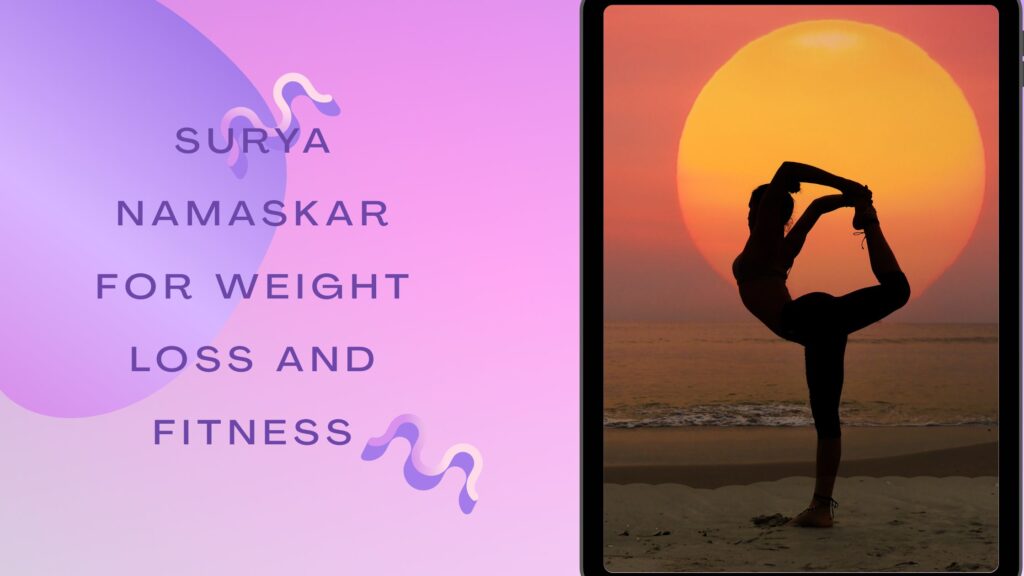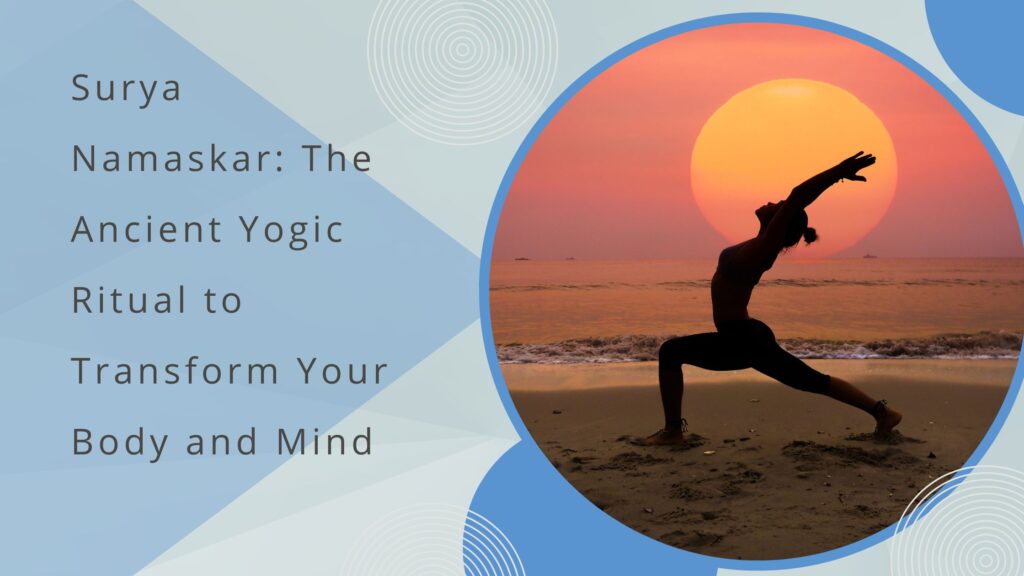In today’s fast-paced world, where stress, poor posture, and sedentary lifestyles have become the norm, a time-tested remedy stands tall — Surya Namaskar, or Sun Salutation. Whether you’re a beginner seeking holistic wellness or a seasoned yogi deepening your practice, integrating Surya Namaskar into your daily routine can create profound changes in your life.
But what is Surya Namaskar, why has it captivated millions globally, and how can you unlock its full potential?
Let’s dive into this ancient yogic practice and discover its transformative magic.
Surya Namaskar, or Sun Salutation, is a dynamic yoga sequence made up of 12 poses that transition smoothly from one to the next. Meaning “salutation to the sun,” it serves as a full-body workout that effectively warms up the body and gets it ready for more advanced yoga practices.
Table of Contents
What is Surya Namaskar?
Surya Namaskar, or Sun Salutation, is a dynamic series of 12 powerful yoga postures that flow together harmoniously with the breath. Traditionally performed at sunrise facing the sun, this practice honors Surya — the Hindu Sun God — as the source of all life and energy.
It’s not just a physical workout. It’s a complete practice that blends asana (posture), pranayama (breath control), and mindfulness — making it one of the most efficient yoga sequences ever created.
Why Surya Namaskar Should Be in Your Daily Routine
You may be wondering, “Why Surya Namaskar out of all yoga poses?”
Here’s the truth: One round of Surya Namaskar engages every muscle group, massages internal organs, and boosts metabolism — all in under 3 minutes. Practicing even 12 rounds a day can transform your physical, mental, and emotional health.
Top Benefits of Surya Namaskar:
- Full-body workout – Tones muscles, builds endurance
- Weight loss – Stimulates metabolism and fat burn
- Improved digestion – Activates digestive fire
- Better flexibility & posture – Enhances spine health
- Mental clarity & focus – Promotes mindfulness
- Detoxification – Improves blood circulation
- Hormonal balance – Regulates glandular activity
Surya Namaskar: A Step-by-Step Guide for Beginners
Ready to experience it for yourself? Here’s a breakdown of the 12 Surya Namaskar steps with English and Sanskrit names, perfect for beginners.
Each movement is synchronized with breath — inhale when expanding, exhale when contracting.
1. Pranamasana (Prayer Pose)
- Stand tall, feet together, palms at heart center.
- Focus your mind and set an intention.
- Breathing: Exhale
2. Hastauttanasana (Raised Arms Pose)
- Inhale and stretch your arms overhead.
- Gently arch backward to open the chest.
- Breathing: Inhale
3. Padahastasana (Hand to Foot Pose)
- Exhale and fold forward from the hips.
- Try to touch the floor with palms, keeping knees soft.
- Breathing: Exhale
4. Ashwa Sanchalanasana (Equestrian Pose)
- Inhale; step your right leg back, left knee bent.
- Look upward, stretching the spine.
- Breathing: Inhale
5. Dandasana (Stick Pose)
- Exhale; step the left leg back, forming a straight plank.
- Engage the core and keep the body aligned.
- Breathing: Exhale
6. Ashtanga Namaskara (Eight-Limbed Pose)
- Lower knees, chest, and chin to the floor.
- Keep the hips raised slightly.
- Breathing: Inhale briefly while lowering, then exhale
7. Bhujangasana (Cobra Pose)
- Slide forward; raise the chest.
- Keep elbows close and shoulders relaxed.
- Breathing: Inhale
8. Adho Mukha Svanasana (Downward Dog)
- Lift the hips to form an inverted V.
- Heels pressing down, neck relaxed.
- Breathing: Exhale
9. Ashwa Sanchalanasana (Repeat with Opposite Leg)
- Bring the left foot forward.
- Gaze upward again.
- Breathing: Inhale
10. Padahastasana
- Step the right foot forward, folding into the forward bend.
- Breathing: Exhale
11. Hastauttanasana
- Come up slowly, arms rising overhead.
- Slight backbend again.
- Breathing: Inhale
12. Pranamasana
- Return to standing posture, palms at the chest.
- Breathing: Exhale
Repeat the sequence using the opposite leg in step 4. One complete Surya Namaskar round includes both right and left sides.
| Step | Pose Name (Sanskrit) | English Name | Breathing | Key Benefits |
| 1 | Pranamasana | Prayer Pose | Exhale | Centering, grounding, improves focus |
| 2 | Hastauttanasana | Raised Arms Pose | Inhale | Stretches chest and abdomen, improves posture |
| 3 | Padahastasana | Hand to Foot Pose | Exhale | Enhances flexibility, stimulates digestion |
| 4 | Ashwa Sanchalanasana | Equestrian Pose | Inhale | Strengthens legs, opens hips, improves balance |
| 5 | Dandasana | Stick Pose | Exhale | Builds core strength, aligns spine |
| 6 | Ashtanga Namaskara | Eight-Limbed Salutation | Exhale | Tones arms and chest, builds stamina |
| 7 | Bhujangasana | Cobra Pose | Inhale | Expands chest, strengthens back and spine |
| 8 | Adho Mukha Svanasana | Downward-Facing Dog | Exhale | Stretches full body, boosts circulation |
| 9 | Ashwa Sanchalanasana (opposite leg) | Equestrian Pose | Inhale | Same as step 4, balances both sides |
| 10 | Padahastasana | Hand to Foot Pose | Exhale | Deepens hamstring stretch, calms nervous system |
| 11 | Hastauttanasana | Raised Arms Pose | Inhale | Opens heart, energizes body |
| 12 | Pranamasana | Prayer Pose | Exhale | Completes cycle, restores awareness |
How Many Rounds of Surya Namaskar Should You Do Daily?
If you’re new, start with 2 to 4 rounds. Gradually build up to 12 rounds for optimum benefits. Advanced practitioners sometimes go up to 108 rounds during spiritual or wellness festivals like International Yoga Day.
Each round takes about 2-3 minutes, making it perfect for busy people who still want a full-body workout.
Read More: Teaching Yoga for Beginners: The Ultimate Guide to Starting Strong
Read More: Ayurvedic Diet for Yoga: A Complete Guide to Nourishing Body, Mind, and Spirit

Surya Namaskar for Weight Loss and Fitness
Yes! It’s a powerful calorie-burner. Just 30 minutes of continuous Surya Namaskar can help burn 250–400 calories, depending on your pace and body type. Combine it with a healthy diet, and you have a sustainable, holistic weight loss plan.
Additionally, it tones the arms, legs, abdomen, and back, improves posture, and enhances core strength — making it a top choice for fitness enthusiasts.
When and How to Practice Surya Namaskar
Best Time:
- Early morning (sunrise) on an empty stomach is ideal.
- Evening (at least 3 hours after a meal) is also acceptable.
Best Place:
- Clean, well-ventilated space or outdoors facing the sun.
What You Need:
- Yoga mat (optional), comfortable clothing, water (after practice)
Preparation Tips:
- Start with a few minutes of deep breathing or warm-up
- End with relaxation or a short meditation (Savasana)
Spiritual and Energetic Benefits of Surya Namaskar
Surya Namaskar isn’t just a physical practice — it’s deeply spiritual. Each pose corresponds to a different chakra (energy center) and is connected to one of the 12 names of the sun. When performed with awareness and devotion, the sequence can:
- Enhance spiritual growth
- Balance pranic energy
- Awaken inner vitality and intuition
Some practitioners even chant mantras with each pose for added vibrational energy.
Surya Namaskar Variations
Over time, different schools of yoga have developed unique styles of Surya Namaskar:
- Hatha Yoga Surya Namaskar: Slow, meditative, breath-focused
- Ashtanga Vinyasa (A & B): Fast-paced, athletic, linked with Ujjayi breath
- Sivananda Style: Includes additional poses and chants
- Bihar School Version: Emphasizes mindfulness and inner awareness
Choose the one that aligns with your goals and energy level.
Who Should Avoid Surya Namaskar?
While it’s generally safe, some people should take precautions or consult a doctor/yoga therapist before practicing:
- Pregnant women (unless supervised)
- People with high blood pressure or heart issues
- Those with recent injuries or surgeries
- Individuals with hernia or severe back pain
Final Thoughts: Transform Your Life with Just 15 Minutes a Day
The beauty of Surya Namaskar lies in its simplicity and depth. With just 10–15 minutes a day, you can:
- Boost your physical strength
- Balance your hormones
- Cultivate mental clarity
- Connect to a higher self
Whether you seek better health, more energy, or inner peace, Surya Namaskar offers a time-tested path toward a balanced and vibrant life.
So why wait?
Step onto the mat, greet the sun, and salute the life within.
Your transformation starts with the first breath.
Bonus: Quick Recap of Key Points
- Surya Namaskar = 12-posture sequence synchronized with breath
- Ideal for weight loss, flexibility, mindfulness, and detox
- Perform 4–12 rounds daily for best results
- Safe, natural, and deeply energizing
- Suitable for all ages with modifications
FAQ:
Q. What is Surya Namaskar and why is it important?
Ans: Surya Namaskar, or Sun Salutation, is a sequence of 12 yoga poses performed in a flow. It offers a complete workout for the body and mind, improving flexibility, strength, metabolism, and focus.
Q. How many rounds of Surya Namaskar should I do daily?
Ans: Beginners can start with 4–6 rounds, gradually increasing to 12 rounds daily for maximum benefits. Advanced practitioners may go up to 108 rounds during special practices.
Q. Can Surya Namaskar help with weight loss?
Ans: Yes! Practicing Surya Namaskar daily boosts metabolism, burns calories, and tones the body, making it highly effective for weight loss and fat reduction.
Q. What is the best time to do Surya Namaskar?
Ans: Early morning at sunrise on an empty stomach is ideal. However, it can also be done in the evening, at least 3 hours after a meal.
Q. Is Surya Namaskar suitable for beginners?
Ans: Absolutely. Surya Namaskar is beginner-friendly and can be modified as needed. Starting slow and focusing on breath alignment ensures a safe and effective practice.
Q. What is the main purpose of Surya Namaskar?
Ans: Surya Namaskar, or Sun Salutation, is primarily intended to channel the sun’s energy into the body while honoring it as a symbol of life, vitality, and renewal. Additionally, it functions as a physical practice that enhances strength, flexibility, and overall health.
Q. What is the history of Surya Namaskar?
Ans: Surya Namaskar, or “sun salutation,” traces its origins to ancient Vedic India, where the sun was worshipped as a powerful deity. Though today it is recognized as a series of yoga postures, it originally emerged from elaborate rituals that included mantra chanting and physical prostrations performed at sunrise to honor the sun. The contemporary sequence of poses was later developed and gained popularity in the early 20th century.
Q. Who cannot do Surya Namaskar?
Ans: Surya Namaskar (Sun Salutation) is not advisable for individuals with specific health conditions such as back pain, spinal issues, coronary artery disease, hernia, peptic ulcers, or wrist injuries. It is also generally discouraged for pregnant women, those who are menstruating, and individuals with high blood pressure or heart conditions. However, with appropriate modifications and under the supervision of a qualified yoga instructor or healthcare professional, some of these conditions may be managed safely.
Q. Which leg is first for Surya Namaskar?
Ans: Begin Surya Namaskar by stepping forward with your right leg, as the Surya Nadi (solar energy channel) flows along the right side of the body. This practice should be done facing the rising sun in the morning.
Q. Should we do Surya Namaskar fast or slow?
Ans: You can adjust the pace of Surya Namaskar depending on your goals. A faster pace may support weight loss, while a slower pace is ideal for improving flexibility and deep stretching. A moderate pace can help tone and strengthen the muscles.
Declaration Note:
We use third-party videos and images on https://yogavidhi.com/ for educational and illustrative purposes. All rights belong to their respective owners. No copyright infringement is intended.



